Driving a Bethel Rig
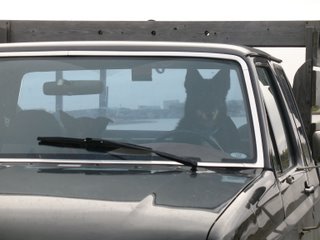
Every year I make at least one trip to the lower 48, to visit immediate family in Washington State and Florida, and extended family in Alabama and Kentucky. Often this trip is paired with attendance at the annual conference of the American Academy of Physician Assistants; in recent years I have attended conferences in Atlanta, Chicago, Boston, New Orleans, Orlando and San Francisco. Trips “Outside” (meaning out of Alaska) tend to reset one’s perspect-o-meter on many topics, particularly those related to population density and attitudes towards conveniences, among others. It really is a whole different world down there.
One of the things I never cease to marvel at is the high percentage of brand-new, spanking-clean cars I see on the (always paved) roads. If I stand on a street corner and watch the cars go by, it seems like nine out of ten are less than five years old (maybe even less than three years old, but I’m not really up on year-to-year model changes) and recently washed. The one out of ten that is older than five years is often an obviously cherished antique, even more lovingly cared for than the new vehicles. The bombs and the wrecks are pretty few and far between, especially in the big cities. My grandmother lives in a fairly rural part of Kentucky, and when I visit her I do see many older vehicles; but there are still quite a few shiny new ones cruising around her small town—including hers! At 93, she lives alone and drives her nearly-new Cadillac everywhere she wants to go. She’s quite the pistol.
Vehicles in Bethel tell a completely different story. Our local transportation falls into three categories: trucks, cars and cabs. The cabs are a story unto themselves; we have a huge number of them. Our cab-to-population ratio probably equals that of New York City. Most of the cabs are older, low-slung sedans like Crown Victorias, which makes no sense in this environment. They get stuck in the mud or snow quite frequently. About 80% of Bethel is unpaved, and the town is built on the dirt banks of a wide, shallow river. We know about mud. Each of the half-dozen or so cab companies has its own tow truck, which it sends out regularly to haul its minions out of bad situations.
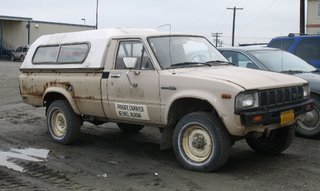
Of the other two categories, trucks outnumber cars by about two to one. Most people drive pick-up trucks, with Ford F-150s being highly favored. Very few of them are newer than 2001 models, and many are earlier than 1996. Almost none of them are clean. Some of them make you wonder if anything besides caked-on mud is holding them together. The word “rattletrap” springs to mind. If Bethel had any type of emission-control testing or requirement to pass a vehicle inspection, I would bet 75% of the vehicles in Bethel would be taken off the road.
Part of the reason we have so many clunkers is that most people bring at least one vehicle with them when they move here, but hardly anyone takes them when they leave. Bethel is essentially a land-locked island; access is only by air or water, as no roads come here from anywhere else. To bring a vehicle to Bethel costs about $2500; taking it away is only slightly less, so people mostly don’t. There are plenty of old beaters for sale around town with a few more years of life in them. Those with unique appearances become like acquaintances in and of themselves, and their successive owners simply faces in a revolving door. Every few years the face driving it changes, and you know it’s been sold again.

One of the items of interest to the knowledgeable used-vehicle buyer in Bethel is how many “Bethel miles” the vehicle has. Since all vehicles come here from somewhere else, most of the miles on the odometer are presumed to have been acquired there. Which probably means on paved roads.
Bethel miles are about the toughest and most destructive a vehicle can take on. The six paved miles of state highway that run out to the airport are patched and repatched due to the sudden appearance of axle-bending potholes, and have lots of little up-and-down hills due to shifting tundra. Tough on the suspension.
The 20+ miles of streets in town are all dirt and gravel. They are constantly sinking due to the frost-heaving tundra they are built on. A day of two of rain and most have a washboard surface with lots of potholes. Add to that the fact that most of Bethel does not have piped water and sewer; these services are provided by large, heavy trucks running six days a week year round, which provides a huge wear factor on the condition of the streets.
This is a delicate item of discussion in our house, as both Bethel’s streets and the water/sewer systems are city services that fall under Dutch’s management. He has a personal concern regarding criticisms about either. It is important to understand (attention newcomers!) that maintenance of Bethel’s streets is a never-ending proposition. They must be raised (read: LOTS of dirt hauled in and spread) every couple of years. And topped with gravel, which the tundra eats. Washboards and potholes are a given, and grading the roads to smooth them out cannot happen in the rain. If the roads are too wet when the grader passes, it turns the road into mud soup, which is worse than the potholes. Most of the complaints that reach Dutch’s office are from newbies who move here with Beverly Hills expectations about how the streets should be.
Bethel miles also include those acquired driving on the Ice Road. In the winter the Kuskokwim River freezes into an ice sheet more than five feet thick. By late December, cars and trucks are driving on it to the nearby villages, some years as far as Aniak, 150 miles away. If the weather is windy and stormy in the last few days and weeks of freeze-up, the frozen surface of the river can be quite rough; if it is calm, the ice surface can be slick as glass. After a few snowfalls, the constant transitions from packed snow to bare ice on different parts of the Ice Road are also pretty rough on vehicles.
If you are getting the impression that this is not a place you would want to bring a brand-new car or truck, you are right. Bethel is tough on vehicles, and most folks would rather drive something dependable (with a good heater) but not necessarily gorgeous. Around here, one’s “ride” is not a projection of one’s persona or one’s status.
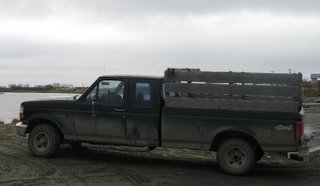
So meet my truck. A 1996 F-150 with the wooden rails and chain snaps around the bed that designate it a “dog truck.” It can carry up to 20 sled dogs (tightly packed; they have to be friends) and two sleds at a time. At ten years old, my truck falls into the “newer” category of Bethel rigs. Henry’s truck is a 1984 F-150 (seen below with a load of dogs headed for summer bare-ground training); Joan’s truck is a 1982 F-150. Both run great and are quite dependable, though you’d never accuse either of being pretty.
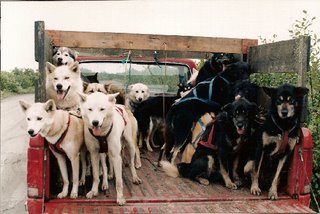
How I acquired this truck is one of those “it could only happen in Bethel” stories. In February of 2000, I bought a team of sled dogs and became a real musher (before that, I drove one of Henry’s teams, which is only being a fake musher). I needed a way to transport them to summer training sites outside the town limits, and the 1994 Ford Explorer I was driving wouldn’t do it. I started looking around at the trucks in town and talking to various owners to get an idea of what I wanted. I’d never owned a full-size pick-up before.
One day I stopped at the grocery store and noticed a guy sitting in his F-150 in the parking lot, so I went over to ask him how he liked his rig. He said it was fine as trucks went, but with two kids and his wife pregnant, he really needed a family car.
“What are you driving?” he asked.
I pointed out my Explorer and his eyes narrowed. He got out and walked around it, looked inside, checked the mileage (“How many Bethel miles?”), and said “Wanna just trade?”
Wow. I wasn’t sure what to say except “Sure!” Being newer and lots more vehicle, his truck was worth quite a bit more than my car; after checking blue book estimates on both, we made the trade the next day and I gave him an additional $2,000. We were both quite happy with the deal. I built the rails on the back, complete with drop chains for the dogs, and became the proud owner of what Henry proclaimed to be “Bethel’s finest dog truck.”
 This is a photo of my truck with outstanding musher Aliy Zirkle and her dog team loaded up and headed to the start of the Kuskokwim 300, Bethel’s annual mid-distance sled dog race. This past January was Aliy’s first running of the K-300; she did the race to put some experience on her puppy team in preparation for upcoming Iditarods, and they did well. Dutch and I were her host family, and we hope she will come back every year and stay with us. She is a charming young woman and a very talented musher. She was the first woman musher to win the Yukon Quest, a 1000 mile sled dog race between Fairbanks and White Horse, in 2000. You can learn more about Aliy and her mushing program at her website, www.aliyzirkle.com.
This is a photo of my truck with outstanding musher Aliy Zirkle and her dog team loaded up and headed to the start of the Kuskokwim 300, Bethel’s annual mid-distance sled dog race. This past January was Aliy’s first running of the K-300; she did the race to put some experience on her puppy team in preparation for upcoming Iditarods, and they did well. Dutch and I were her host family, and we hope she will come back every year and stay with us. She is a charming young woman and a very talented musher. She was the first woman musher to win the Yukon Quest, a 1000 mile sled dog race between Fairbanks and White Horse, in 2000. You can learn more about Aliy and her mushing program at her website, www.aliyzirkle.com. .
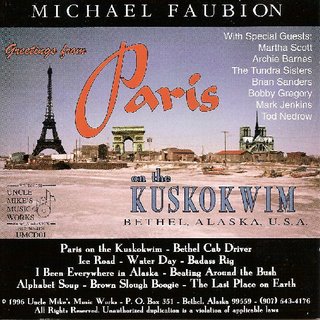 Bethel’s musical claim to fame is a CD I’ve mentioned before, Greetings from Paris on the Kuskokwim by Michael Faubion. He used to live here, but moved to Anchorage a few years ago. One of the songs on the album is entitled “Badass Rig” and is a tribute to the type of truck most of us drive here. The chorus goes:
Bethel’s musical claim to fame is a CD I’ve mentioned before, Greetings from Paris on the Kuskokwim by Michael Faubion. He used to live here, but moved to Anchorage a few years ago. One of the songs on the album is entitled “Badass Rig” and is a tribute to the type of truck most of us drive here. The chorus goes:It’s big and it’s ugly; it gobbles up the gas.
If the Bethel roads’d let it, it’d go real fast.
Four-wheel drive and the motor’s real big,
It’s a rut-ridin’, boat-totin’, dog-haulin’ badass Bethel rig!
So back to the start of this post. Those annual visits to the lower 48 feel like treks to the Heart of Civilization (Anchorage is only an Outpost). I go through something akin to culture shock every time, not only on arriving there, but also on returning here. These trips are a regular reminder that I live on America’s Last Frontier. It’s just different here.
Labels: Life in Bethel




9 Comments:
Yep, and from the sounds of it, worth every hardship you have to endure. I wish I was 20 years younger ... it'd be high on my list of places to give a try.
Still sounds like a fabulous place to live.....but what happens to the sewerage? I'm guessing that it's too cold for septic tanks/soakaways....
wil--I have a feeling you'd fit right in!
oz--it is a fabulous place, IMHO. I wrote about the hauled water and sewer systems in a previous post last June entitled Life in Bethel. Check the June archives for it if you'd like to know more...
hey oz--thanks for listing me as one of your favorites on the British expat site. I am honored. Several visitors have stopped by as a result...
FYI-- someone else likes your writing, too.
"Driving a Bethel Rig: In the winter the Kuskokwim River freezes into an ice sheet more than five feet thick. ... rails and chain snaps around the bed that designate it a “ dog truck. ... proud owner of what Henry proclaimed to be “Bethel’s finest dog truck. ..."
http://www.smellysite.com/dog-bed-sheet/2006/10/dog-bed-sheet/Driving-a-Bethel-Rig.html
You're welcome! I felt that the world should know about you and your community :)
Thanks for the tip, mpb! I tried to run this down and found it somewhat frustrating. The entire link as you've listed doesn't work directly. I had to go to smellysite.com and follow links (each of which opened a new window) to dog beds and then dog sheets and then Driving-a-Bethel-rig. And then the entirety of what I found there was exactly what you've listed in your comment. And no attribution. I totally do not get this website. It seems to be nothing but ads and pirated copy from other websites with no mention of original sources. No author, no contact, no way to comment. WTF??
My pirated copy was pretty deeply embedded; how did you find it?
The site is a splog (spam web log). Unfortunately, there isn't much stolen to go into plagiarism (theft by a thousand cuts). Loreel VanFossen has some good tips (http://lorelle.wordpress.com) e.g., http://lorelle.wordpress.com/2006/10/09/
copyrights-and-the-blogger-protect-what-is-yours/
I'm a human biologist and support grassroots science for the Yukon Nushagak Kuskokwim region, e.g., H5N1 (environment, safety, health)(http://ykalaska.uniblogs.org and related blog)
To make a better effort, I track news and blogs on our region. This is how I came up with stories about the Aleut Indians (sic) and "Pacific American Indians" who live in Hooper Bay (see entry 29 or so at http://www.apstylebook.com/ask_editor.php)
And your other persona.
mpb--thank you for the pointer to Van Fossen's site; there is much good information there on copyrights, blogger protection, and what to do when (not if) blog content is stolen. Reading through it gave me a good dose of reality. There is now a copyright statement on the TMD front page, which had been naively lacking before.
I found good stuff about our region on your site as well. Nice photo of geese in flight, and interesting info about water resources and more.
Thanks for visiting, and for commenting.
Post a Comment
<< Home